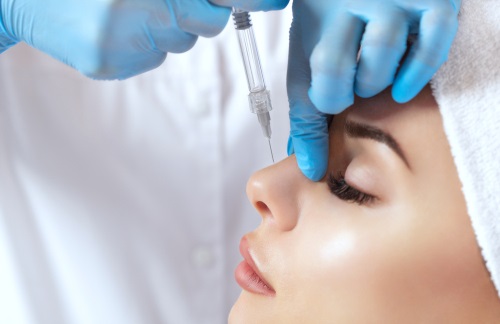The venesection was painless to say the least, thank you for using local anaesthetics; highly recommended
Chemical Peel Treatment in London
A chemical peel is a popular skin resurfacing treatment for skin rejuvenation due to its ability to remove the top layers of skin and promote new collagen and elastin production. This results in new, healthy, plump and flawless skin. With three levels of chemical peel, it is possible to treat a wide range of skin issues and reduce wrinkles and fine lines.
The strength of a chemical peel will be determined by your own concerns and the results you want to achieve. During the treatment, a chemical solution is applied to your skin, which removes the skin’s outer layer (epidermis). As your skin heals, the new layer of skin is smooth and plump due to the enhanced collagen and elastin fibres that are formed.
Chemical peels rejuvenate skin with great clinical efficacy. They work by stimulating the body’s natural healing process to thicken and increase volume in the epidermis while reducing sun damage-induced uneven skin discolouration. Depending on your desired outcome, they come in three different levels of intensity, superficial, which affects just the top layer of skin, medium depth, affecting both layers and deep-reaching through most dermal tissue for better long-term results!
A skin peel in London at Harley Street MD is beneficial for those with acne scarring, dilated pores, greasy and acne-prone skin, severe sun damage and dark spots, and uneven skin tone. Chemical peels also reduce age-related skin changes such as fine lines and wrinkles and improve skin texture and tone. If you are unhappy with your skin and experiencing any of the above skin conditions, get in touch with our clinic to see if a chemical peel is the right treatment to address your skin concerns.
Types of Chemical Peels
Depending on your desired outcome, chemical peels come in three different levels of intensity, superficial (just affecting the epidermis), medium-depth (affecting the entire epidermis and papillary derm) and deep (reaching the mid reticular level).
When used correctly for specific indications, chemical peels are considered safe and are a clinically proven method to greatly improve skin texture and tone. Let’s take a more in-depth look at each type of chemical peel and precisely what results you can expect from each one.
Superficial Chemical Peels — Alpha-Hydroxy Acid (AHA) Peels
A superficial or light peel is the mildest of the three chemical peels and is sufficient to improve minor skin blemishes, pore size, oiliness and acne. This peel can be used more regularly to maintain plump skin and resolve mild skin issues, such as acne. The results are more subtle but will improve significantly over time, especially when coupled with a good skincare routine and a healthy lifestyle.
AHA comes in various strengths ranging from as low as 20% up to 70%
Recognised brands include: Filorga®, Neostrata®, Agera®, Obagi® Radiance Peels
• Effect — Exfoliates and removes the top superficial layer of the skin
• Result — Reduces pore size and mild skin pigmentation and helps to treat acne.
• Number of treatments — A course of four to six treatments is recommended for the best results, with each treatment performed one to two weeks apart
• Downtime — This will vary from mild redness to some skin flaking for two to three days, depending on the percentage of AHA in the peel.
• Aftercare — You will need to avoid sun exposure for two weeks.
Medium Chemical Peels (i.e. Trichloroacetic Acid Peels)
A medium or intermediate chemical peel can considerably improve the appearance of fine lines, deep wrinkles and sunspots. Penetrating the middle layers of the skin, a medium peel stimulates the production of new collagen and restores the extracellular matrix to optimal condition.
A chemical peel in London at our aesthetic clinic can reverse the effects of skin ageing and damage with unprecedented results. Depending on the degree of skin damage and depth of your wrinkles, you may need multiple treatments to get your desired results. Results last around one year after a course of treatments.
TCA comes in concentrations ranging from 20% to 70%
Recognised brands include: SkinTech®, Obagi® Blue Peels
• Effect — Penetrates a deeper layer of the skin through the epidermis and into the papillary dermis
• Result — Increase cell growth leading to an increase of collagen production, softening wrinkles and reducing pigmentation, making skin look more even, plumper and smoother
• Number of treatments — Three to five treatments are advised for optimal results, administered one to two weeks apart.
• Downtime — Redness, flaking and peeling for between seven to 10 days
• Aftercare — You will need to avoid sun exposure for two weeks.
Deep Chemical Peels (i.e. Phenol Acid Peels)
This most intense chemical peel requires anaesthesia and a much longer recovery time. We do not offer this skin peel in London, at Harley Street MD, as deep chemical peels are associated with higher risks and complications. For this reason, we will refer you if we feel this is the most appropriate peel for your individual skin concerns and desired outcome.
What Are the Side Effects of Chemical Peels?
During the treatment, you will feel a stinging or burning sensation while the chemical peel works to eliminate dead skin cells. This is totally normal, and the after effects of chemical peels will vary based on your skin and the type of peel you receive. Since the procedure removes layers of the skin, side effects include:
• Peeling
• Redness
• Swelling
• Itching and irritation
• Infection.
Rare complications such as scarring or changes in skin colour may occur, although this is a much greater risk with deep peels. Each type of chemical peel requires aftercare and has a recovery time, so we advise that you do not schedule any important events following your treatment. It’s also critical to avoid sun exposure, use high quality sun protection and follow all aftercare instructions to reduce the possibility of any side effects.






















